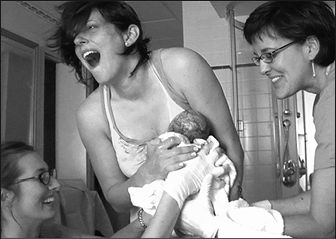By SARAH NORRIS
THE BUSINESS OF BEING BORN
Through January 15
IFC Center
323 Sixth Ave. (at West 3rd St.)
(212 924-7771; ifccenter.com)
When it premiered at the 2007 Tribeca Film Festival, the documentary “The Business of Being Born” was hailed as “An Inconvenient Truth” for pregnant women. The reality is, however, that this documentary examining modern-day birth practices resonates with women and men of all ages by tapping into primordial truths.
That labor offers the most excruciating pain of a woman’s life — and is to be avoided with drugs and possibly rendered in a state of unconsciousness — is a widely accepted view. “The Business of Being Born” shows us the alternative: Childbirth as an empowering and valuable experience, and it comes as both a revelation and a great relief.
“I wanted a home birth experience almost as much as I wanted a second child,” says executive producer Ricki Lake, describing the impetus that fueled her interest in the subject. “I love pain medication; I don’t want to feel even a headache. But when it came to giving birth, it wasn’t something that needed to be numbed. It was something to be experienced.”
Lake and director Abby Epstein clearly did their homework, gathering the statistics and a wide range of interview subjects, but the most gripping scenes are the ones of home births themselves. Footage from 2001, of Lake giving birth in her bathtub, is astonishing as are the other pregnant women featured in their apartments and in birthing centers. During filming, Epstein unexpectedly became pregnant and her story plays an instrumental role in balancing the movie. One of the film’s major threads tracks a New York midwife, Cara Muhlhahn, as she visits her patients both before and during their labor process. Contrasts between the home birth experience and the hospital delivery are writ large, the latter depicted as more frightening and even isolating.
The film criticizes the ways in which hospitals fail women, a result of the myriad types of birth intervention, from labor-inducing drugs like Pitocin to Cesarean sections, which account for 29% of births in this country. Dr. Michel Odent, an OB/GYN, says, “We are completely lost and have forgotten to raise the most simple questions: What are the basic needs of women in labor?” After Dr. Michael Brodman, Chief OB/GYN at Mt. Sinai Hospital, reveals that the peak hours for C-sections are 4 p.m. and 10 p.m., he explains that these are the times when doctors want to go home, either for dinner or the night.
Among developed countries, the United States possesses the second worst newborn death rate — in part the filmmakers theorize, because of a fear factor that leaves delivery entirely up to doctors, who are overqualified for normal and uncomplicated labor. When three OB/GYN residents at Manhattan’s Bellevue Hospital are asked how often they get to witness a fully natural birth, they shake their heads: “Almost never.” Susan Hodges, president of Citizens for Midwifery, adds, “In medical school and in the hospital, it [natural birth] is almost an oxymoron.”
“Telling my story,” Lake says now, “and how transformed I was [by the home birth] was something I had to share. It has to strike a chord because all of the culture’s negative thoughts and fear contribute to a woman feeling that she can’t do it. You can do it.”
Midwife Cara Muhlhahn, whose own labor is featured, reveals that when it comes to childbirth, a woman doesn’t need to be rescued. “It’s the place for her to face her darkest moment and lay claim to her victory.” “The Business of Being Born” is an enormously uplifting film, inspiring for the trust women have in their own bodies and the strength, both physical and mental, they call on, to miraculous effect.
…


























